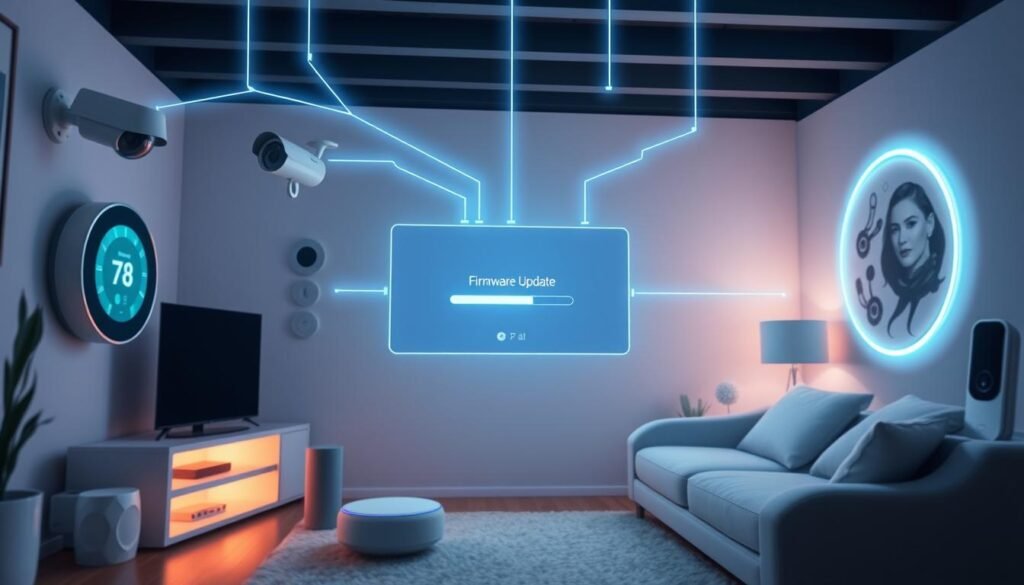About 58% of people worry about their smart home security. This shows a big concern in our connected world1. Smart homes are becoming more popular, but they also have big security risks. With 85.6% of IoT users fearing hackers, keeping your home safe is more important than ever2.
In this article, you'll learn how to protect your smart home from hackers. This way, you can enjoy smart technology safely and keep your data private.
Knowing the risks of smart devices and acting early can help a lot. Many people forget to update their devices or change passwords. 34% of smart device owners don't update their software often1. By focusing on protecting your IoT devices, you can lower these risks and have a safe smart home.
Key Takeaways
- • Over half of consumers are worried about the security of their smart devices.
- • Changing default passwords is crucial, yet many do not.
- • Regular updates help protect against known vulnerabilities.
- • Multi-factor authentication can drastically enhance device security.
- • Understanding the unique risks of smart devices is key to their protection.
Understanding the Vulnerabilities of Smart Home Devices
Smart home technology is changing how we live, but it also brings big risks. Devices are often connected, making security harder to manage. Many people don't realize that weak settings and default passwords make these devices easy targets for hackers3.
About 72% of people worry about the security threats to their personal data4.
These growing privacy risks are not just about protecting data. They can also lead to serious problems, like hackers controlling your smart locks or watching you through cameras. Many devices don't have strong security, leading to data breaches and invasive monitoring5.
Devices like cameras, lights, and thermostats often lack good security. This makes them easy to hack. Hackers can mess with your devices or watch you through cameras, risking your home network4. Knowing these risks helps you find ways to make your smart home safer.
Assess Your Smart Home Needs
Start by figuring out which smart devices will really make your life better. Think about how each device might affect your privacy, especially if it records video or audio. For example, security cameras are great for watching over your home, but where does the footage go and who sees it?
It's important to weigh the good against the bad for each smart device. With over 12,000 hacking attempts in just one week in 2021, keeping your devices safe is crucial6. Choose devices that make your life easier and keep your home secure. Using tools like 1Password or Bitwarden can help protect your data6.
When exploring smart home tech, always put security first. Update your passwords often and use multi-factor authentication to stay safe7. Make sure each device fits well with your lifestyle and security needs. This careful planning ensures your home is both smart and secure.
How to Secure Your Smart Home Devices Against Hackers
Smart home technology is becoming more popular, but it also brings risks. Devices like virtual assistants and security systems are convenient but can be hacked. Knowing the risks helps you protect your home.
Identify Key Risks
Smart devices are at risk because they connect to the internet. A study found that 90% of these devices can let hackers into your network8. Also, 75% of routers have security flaws, making it important to update them8.
Choosing trusted brands can lower security risks by up to 80%8. This is because these brands offer reliable updates and services.
Balance Convenience and Security
Smart devices make life easier, but you must also focus on security. Using unique passwords for each device can cut hack risks by 70%8. Update your passwords often and use high-security settings.
Creating a separate Wi-Fi network for smart devices can reduce threats by 60%8. This keeps your main network safer.

It's key to know your devices' security features before connecting them. This helps avoid common security mistakes. Using password managers, like 1Password, helps keep your passwords safe9.
By following these steps, you can enjoy modern tech while keeping your home secure. For more tips, check out this guide10.
Secure Your Wi-Fi Network
Your Wi-Fi network is key for all your smart home devices. It's very important to keep it safe. Many home networks are open to threats because of simple mistakes, like not setting up router configurations right. By taking steps ahead of time, you can greatly reduce the chance of cyberattacks on your smart home.
Change Default Passwords
Changing your router's default passwords is a crucial first step. About 43% of users still use the default login details, making it easy for hackers to get in11. Default settings often have common usernames and passwords that hackers know. Make strong, unique passwords for your router and each device connected to it12.
Use WPA2 or WPA3 Encryption
To make your network even safer, use strong encryption. Around 70% of home networks don't have Wi-Fi encryption, making them easy targets for hackers11. WPA2 or WPA3 encryption is better than older methods like WEP. These protocols protect your data and keep your network safe from intruders and data breaches13.

Regularly Update Firmware
Keeping your smart devices safe depends on firmware updates. These updates fix security issues and make your devices work better. If you don't update on time, your devices could get hacked. It's important to update often because manufacturers do it to protect your devices.
Make sure to check for updates often. Also, look for devices that can update automatically for you.

Importance of Timely Updates
Updating your devices quickly is key to keeping your smart home safe. It reduces the chance of hackers getting in. While passwords are important, they're not enough against new threats.
Updating your devices and using two-factor authentication (2FA) adds extra security. This makes it harder for hackers to get to your data. It's a smart way to protect yourself from cyber attacks.
Register Devices for Automatic Updates
Registering your devices for automatic updates is a smart move. It saves you from having to update them yourself all the time14. Keeping your firmware current helps block many cyber threats, like data breaches.
Also, turning off features you don't use can help keep hackers out15. By doing these things, you help make your smart home a safer place.
Replace Outdated Routers
Old routers can be a big security risk for your smart home. They might not have the latest features to protect against hacking and testing. It's key to check if your router can handle new security options like WPA2 or WPA3 encryption16.
Evaluate Your Current Equipment
Look at how old and useful your router is. Routers over five years old often don't have the latest security16. Also, think about how many networks your router can handle. Modern routers let you create separate networks for your smart devices, adding security16.
Benefits of Upgrading to Wi-Fi 6 or 7
Getting a Wi-Fi 6 or 7 router boosts your network's speed and security. These models offer better encryption and faster data transfer17. They also protect against hacking, making them essential for a smart home. Upgrading your router helps fight off new cyber threats17.
Manage Your Account Passwords
Keeping your account passwords safe is key to a secure smart home. Use different passwords for each device to protect your network. Don't reuse passwords, as it makes your accounts more vulnerable to hackers.
Utilize Unique Passwords for Devices
Make sure each smart device has a unique, strong password. Weak passwords can let hackers into your home systems18. A good password mixes letters, numbers, and symbols. Change these often to boost your cybersecurity for smart homes.
Here's a simple way to create passwords:
| Device Type | Recommended Password |
|---|---|
| Smart Light Bulb | Light!23Bulb#Secure |
| Security Camera | Camera$Secure123! |
| Smart Thermostat | Thermostat!Safe456* |
| Garage Door Opener | Garage^Door789#Access |
Employ Password Managers
Password managers help keep your online security strong. They let you create and store complex passwords safely. This lowers the risk of password breaches and keeps you safe from privacy threats.
They also remind you to update weak passwords. With more smart homes, protecting yourself is more crucial than ever18. By securing your Wi-Fi and updating devices, you'll make your smart home safer.
Enable Multi-Factor Authentication (MFA)
In today's world, keeping your smart home devices safe is key. Using Multi-Factor Authentication (MFA) boosts your smart home's security. It asks for more than just a password, like a fingerprint or face scan, to get in. This makes it hard for hackers to get in.
Adding MFA makes your home network stronger. It's what experts suggest to keep your devices safe.
What is MFA?
MFA means using more than one way to prove who you are. This could be a password, a phone, or a fingerprint19. It's a strong way to stop hackers who guess passwords.
Big names like Amazon Echo and Google Nest use MFA. They know it's crucial for keeping your data safe20.
Benefits of MFA for Smart Devices
MFA helps keep your smart home safe from unwanted visitors. It might take a little extra time to log in, but it's worth it. It lowers the chance of your data getting stolen19.
There are many ways to use MFA, like face scans or special tokens. You can pick what works best for you19. Using MFA makes your smart home more secure and reliable.



